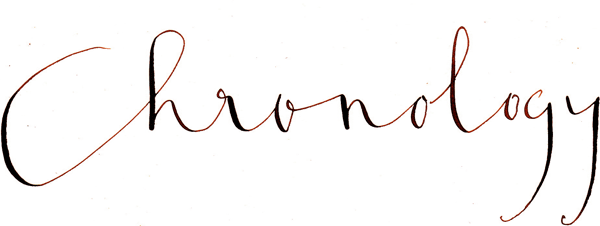
The “chronology”—that sparely written, tidily formatted appendix one finds fitted into the front or back of an edition of a great work by a writer or in a volume dedicated to the writer’s work more generally—is a literary form to which we give not a great deal of thought. Nor, of course, are we meant to. After all, the “chronology” is designed and built to be all function, a bare biography of the artist whose work we have in our hands. It is only expected to offer a thumbnail of the path through life that the person took on the way to and past his work.
No fuss, no flash, the dates of events are given flush left, and are rarely more precise than a year, or even a range of years. One begins:
| 1915 | Born Solomon Bellows in Lachine, Quebec, on June 10, fourth child of Abram Bellows and Lescha Gordin, Russian-Jewish immigrants from St. Petersburg. |
Verbs tend to start the entries in chronologies, their subject shorn from view: no need to say “He was born…” when every entry is about him. Life is thus, if not reduced, rendered as a litany of doings: born; attends; reads; serves; reads; writes; begins; writes; marries; vacations; begins; writes; suffers; obtains; records; makes; gives; teaches; buys; assumes position; spends; spends; impoverished, takes; publishes; publishes; has coronary; refuses; suffers; dies. To tease down to such terseness is not to leach of life. Rather, to read such a economical enumeration of the events of a life is to compel, through descriptive brevity, by reminding us of life’s proscriptive brevity.
Another chronology begins:
| 1895 | Born Edmund Wilson Jr. on May 8 in Red Bank, New Jersey, the only child of Edmund Wilson and Helen Mather Kimball, after a difficult delivery during which his mother was injured by his large head. |
A hundred novelists pant to have a detail as telling as the one fitted to the end of that phrase: the writer, so legendarily smart, whose head, from day one, was dangerously large. Such a detail, of course, might be untrue, but without the padding that longer accounts inevitably admit, chronologies more often evade hagiography; they leave little room for authorial vanity. They are a style of telling a life that focuses on fundamental facts, on undebatables. As such, they are a style of telling the truth of a life, in writing, that also says something important about truth in writing.
For one can do a great deal with very little, the chronology suggests. The big book; the long and winding phrase; the effortfully alliterative style: all fair and good, all reasonable approaches to the making of literary art. And yet, chronology suggests, there is another, humbler way to telling the truth. Or, chronologies remind us, some writing is better suited than some others at orienting our eye on subject. Much of what we like to call “good writing” is about nothing so much as writing and, by extension, its writer. Chronologies suggest there are things more interesting than writers and writing, and do so in writing.
































































































